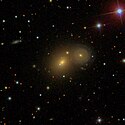NGC 2398
| Galaxie NGC 2398 | |
|---|---|
 | |
| SDSS-Aufnahme | |
| AladinLite | |
| Sternbild | Zwillinge |
| Position Äquinoktium: J2000.0, Epoche: J2000.0 | |
| Rektaszension | 07h 30m 16,1s[1] |
| Deklination | +24° 29′ 16″[1] |
| Erscheinungsbild | |
| Morphologischer Typ | S + S[1] |
| Helligkeit (visuell) | 1: 14,4 mag 2: 14,9 mag[2] |
| Helligkeit (B-Band) | 1: 15,3 mag 2: 15,5 mag[2] |
| Winkelausdehnung | 1: 0.40/0.3 2: 0.50/0.5[2] |
| Positionswinkel | 1: 150°[2] |
| Flächenhelligkeit | 11,9 mag/arcmin² 2: 13,2 mag/arcmin²[1] |
| Physikalische Daten | |
| Rotverschiebung | 0.029724 ±0.000067[1] |
| Radialgeschwindigkeit | (8911 ± 20) km/s[1] |
| Hubbledistanz H0 = 73 km/(s • Mpc) | (395 ± 28) · 106 Lj (121,2 ± 8,5) Mpc [1] |
| Durchmesser | 135.000 + 90.000 Lj[3] |
| Geschichte | |
| Entdeckung | Edouard Stephan |
| Entdeckungsdatum | 10. Februar 1885 |
| Katalogbezeichnungen | |
| NGC 2398 • PGC 21157/21165 • CGCG 117-048 • 2MASX J07301614+2429160 • | |
NGC 2398 ist ein interagierendes Galaxienpaar vom Hubble-Typ S+S im Sternbild Zwillinge auf der Ekliptik. Es ist schätzungsweise 395 Millionen Lichtjahre von der Milchstraße entfernt.
Das Objekt wurde am 10. Februar 1885 von dem Astronomen Edouard Stephan entdeckt.[4]
Weblinks
Einzelnachweise
Auf dieser Seite verwendete Medien
Autor/Urheber: Sloan Digital Sky Survey, Lizenz: CC BY 4.0

Angle of view: 4' × 4' (0.3" per pixel), north is up.
Details on the image processing pipeline: https://www.sdss.org/dr14/imaging/jpg-images-on-skyserver/